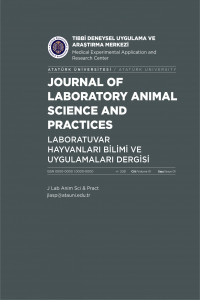Fare Hepatit Virusu(MHV) Üzerine Bir Derleme
Deneysel amaçlı yetiştirilen fareler, enflamasyon, immunite ve enfeksiyonları araştırmanın yanı sıra, yeni tanısal, önleyici ve terapötik yaklaşımlar geliştirmek için de mükemmel bir model görevi görür. Deney hayvanı üretim laboratuvarlarında, sağlıklı deney faresi popülasyonu oluşturmak ve idamesini sağlamak en önemli temel prensiptir. Fare coronavirusu diğer adıyla murine coronavirus/murine hepatitis virus (MHV) deneysel amaçla yetiştirilen laboratuvar farelerinin en önemli patojenlerindendir. Coronaviridae ailesinde, betacoronavirus genusunda yer alan MHV, pozitif polariteli RNA genomuna sahiptir. Zarflı bir virus olmakla birlikte 26-32 kilobaz nükleotid büyüklüğüyle en büyük genoma sahip viruslar arasında yer almaktadır. MHV, virulan suşlar; MHV-1, MHV-2, MHV-3, MHV-JHM, MHV-A59, MHV-S ve daha az virülan suşlar; MHV-D, MHV-DVIM, MHV-Y, MHV-RI, MHV-S ve MHV-Nu olarak iki farklı grupta incelenmektedir. MHV; konakçı immun yanıtına, yaşına, konağa giriş yoluna, virusun genotipine bağlı olarak farklı hastalıklarla seyretmektedir. Bu hastalık tabloları arasında; hepatit, enterit ve nörolojik bozukluklar yer almaktadır. Özellikle asemptomatik saçıcılar olan bağışıklığı iyi gelişmiş yetişkin fareler, sürü içerisinde virusun saçılımında önemli rol oynamaktadır. Laboratuvar hayvanlarının korunmasında düzenli aralıklarda MHV kontrolü yapılması önem taşımaktadır. MHV, ayrıca insan coronavirus enfeksiyonlarının araştırılması açısından da model olarak kullanılan viral etkenler arasında yer almaktadır. Özellikle son yıllarda ortaya çıkan SARS-CoV salgını ve SARS-CoV-2 pandemisinde başvurulan önemli bir virus modeli olarak üzerinde çalışılmaktadır.
Anahtar Kelimeler:
Coronavirus, deney hayvanı, fare, murine hepatitis virus
A Review on Mouse Hepatitis Virus (MHV)
Experimentally bred mice serve as an excellent model for studies on inflammation, immunity, and infections, and to develop new diagnostic, preventive, and therapeutic approaches. In experimental animal production laboratories, the most important basic principle is to establish and maintain a healthy experimental mouse population. Mouse coronavirus, also known as murine coronavirus (MHV), is one of the most important pathogens that cause infections in laboratory mice reared for experimental purposes. MHV, in the family Coronaviridae, in the betacoronavirus genus, has a positive polarity RNA genome. Although it is an enveloped virus, it is among the viruses with the largest genome with a nucleotide size of 26-32 kilobases. MHV, virulent strains MHV-1, MHV-2, MHV-3, MHV-JHM, MHV-A59, MHV-S, and less virulent strains MHV-D, MHV-DVIM, MHV-Y, MHV-RI, MHV-S, and MHV-Nu are examined in two different groups. MHV, It progresses with different disease tables depending on the host immune response, age, route ofentry to the host, and genotype of the virus. These infections includes hepatitis, enteritis, and neurological disorders. In particular, adult mice with well-developed immunity, which are asymptomatic scatterers, play an important role in the shedding of the virus in the herd. It is important to carry out MHV control at regular intervals in the protection of laboratory animals. MHV is also among the viral agents used as a model for the investigation of human coronavirus infections. It is being studied as an important virus model, which is used especially in the SARS-CoV epidemic and SARS-CoV-2 pandemic that has emerged in recent years
Keywords:
Coronavirus, laboratory animals, mice, murine hepatitis virus,
___
- 1.Aydın, H., Timurkan, M.Ö., 2020. Transmission and replication dynamics of SARS CoV-2. Eurasian J Vet Sci, Covid-19 Special Issue, 17-22.
- 2.Atli, K., Saltik, H.S., Yildirim, Y., 2020. Impact of weather conditions and global warming on COVID-19 outbreak. Eurasian J Vet Sci, Covid-19 Special Issue, 118-121.
- 3.Barthold, S.W., 1997. Mouse hepatitis virus infection, intestine, mouse, Digestive System. Springer, pp. 379-384.
- 4.Barthold, S.W., Smith, A., 1983. Mouse hepatitis virus S in weanling Swiss mice following intranasal inoculation. Lab Anim Sci 33, 355-360.
- 5.Barthold, S.W., Smith, A.L., 1984. Mouse hepatitis virus strain—related patterns of tissue tropism in suckling mice. Arch Virol 81, 103-112.
- 6.Barthold, S.W., Smith, A.L., 1987. Response of genetically susceptible and resistant mice to intranasal inoculation with mouse hepatitis virus JHM. Virus Res 7, 225-239.
- 7.Barthold, S.W., Smith, A.L., 2007. Mouse hepatitis virus, The Mouse in Biomedical Research. Elsevier, pp. 141-178.
- 8.Bender, S.J., Weiss, S.R., 2010. Pathogenesis of murine coronavirus in the central nervous system. J Neuroimmune Pharmacol 5, 336-354.
- 9.Cowley, T.J., Weiss, S.R., 2010. Murine coronavirus neuropathogenesis: determinants of virulence. J Neurovirol 16, 427-434.
- 10.Das Sarma, J., 2010. A mechanism of virus-induced demyelination. Interdiscip Perspect Infect Dis 2010, 109239.
- 11.Garcia, A.B., de Moraes, A.P., Rodrigues, D.M., Gilioli, R., de Oliveira-Filho, E.F., Durães-Carvalho, R., Arns, C.W., 2021. Coding-Complete Genome Sequence of Murine Hepatitis Virus Strain 3 from Brazil. Microbiol Resour Announc 10, e00248-21.
- 12.Homberger, F.R., 1997. Enterotropic mouse hepatitis virus. Lab Anim 31, 97-115.
- 13.Körner, R.W., Majjouti, M., Alcazar, M.A.A., Mahabir, E., 2020. Of mice and men: the coronavirus MHV and mouse models as a translational approach to understand SARS-CoV-2. Viruses 12, 880.
- 14.Malik, Y.A., 2020. Properties of coronavirus and SARS-CoV-2. The Malaysian J Pathol 42, 3-11.
- 15.Perlman, S., Jacobsen, G., Afifi, A., 1989. Spread of a neurotropic murine coronavirus into the CNS via the trigeminal and olfactory nerves. Virology 170, 556-560.
- 16.Saltik, H.S., Atli, K., Kale, M., 2020. Severe acute respiratory syndrome coronavirus2 (SARS-CoV-2): pathogenesis and virus-host interactions. Eurasian J Vet Sci, Covid-19 Special Issue, 59-64.
- 17.Yeşilbağ K, Aytoğu G, 2020. Coronavirus host divergence and novel coronavirus (Sars-CoV-2) outbreak. Clin Exp Ocul Trauma Infect, 2, 1-9.
- Başlangıç: 2021
- Yayıncı: Atatürk Üniversitesi
Sayıdaki Diğer Makaleler
Ratlarda Kullanılan Sperma Alma ve Analiz Yöntemleri ile Referans Değerleri
Tavşan Koksidiyozunda Tedavi ve Profilaksi
Fare Hepatit Virusu(MHV) Üzerine Bir Derleme
Oksaliplatin Kaynaklı Testis Hasarı Üzerine Likopenin Etkilerinin Araştırılması
Sefa KÜÇÜKLER, Fatih Mehmet KANDEMİR
Ratlarda Rasyona Katılan Glütenlerin Serum Lipid Profili Üzerine Etkisi
